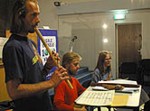Performance of The Birth of Apollo
 Staging the Homeric hymn (8th century BC) to Apollo of Delos.
Staging the Homeric hymn (8th century BC) to Apollo of Delos. Translated from Ancient Greek and directed by Mari Murdvee.
Costume design: Eve Valper
Music arrangements: Toivo Sõmer
Choreography: KĂĽlli Kressa
The cast:
Apollo - Andreas Kalkun
Goddess Leto - Maare-Marika Heinsoo
Storyteller - Andrus Rootsmäe
Singer, Isle of Delos - Mari Murdvee
Chorus - Ulvi Karu, Külli Kressa, Pille Niin, Hedvig Priimägi, Anu Põldsam
 The musicians:
The musicians:
Toivo Sõmer - lute, lyre, tambourine
Heikki-Rein Veromann - flutes
Prologue and Epilogue:
Score for the initial verses of the hymn (1-9) by Mari Murdvee
The songs (in the order of musical fragments performed): Mesomedes. Ode to the Sun
Euripides. Orestes, fr. 3
Mesomedes. Ode to Nemesis
Seikilos' Epitaph (flute)
Athenaios. Delphic paean
Address to the Muse
Address to Calliope and Apollo
Athenian Stranger: I am glad to hear that you agree with me; for, indeed, the discipline of pleasure and pain which, when rightly ordered, is a principle of education, has been often relaxed and corrupted in human life. And the Gods, pitying the toils which our race is born to undergo, have appointed holy festivals, wherein men alternate rest with labour; and have given them the Muses and Apollo, the leader of the Muses, and Dionysus, to be companions in their revels, that they may improve their education by taking part in the festivals of the Gods, and with their help.
(from Plato's Laws, transl. Benjamin Jowett, http://eserver.org/philosophy/plato/laws.txt)
The play "The Birth of Apollo" is based on one of the oldest existing Homeric hymns (appr. VIII century B.C.), describing the story of the birth of Apollo, the God of fine arts, in the isle of Delos. The translation, prepared for this particular production, has retained the original hexametric form of the text. The musical score is built around the few extant fragments of Ancient Greek music, linking these through solo parts and instrumental pieces to the plot. The text and the music of the play are brought together by choreography. The dancing in the play seeks to express the verse's intrinsic rhythms and their connection to music, as it was characteristic of the early Greek tradition. KĂĽlli Kressa's choreography, which may be referred to as "quantitative dance" is an experiment in itself.



